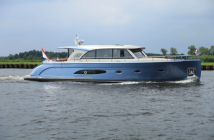Crossing the Gulf Stream to the Bahamas, transiting Delaware Bay, heading into San Diego harbor, wherever you cruise, you’ll end up sharing the water with something larger than your vessel, including freighters or tankers that have very limited maneuverability. Consider that a ship cruising at 20 knots travels one nm every three minutes; you may be on a collision course sooner than you think. Here’s some great advice from Skipper Tips about how to track another vessel to avoid a collision, taking visual bearings. Even in an age of radar and AIS, you need to know how to do this without electronic help:
When you first sight a ship on the horizon, take a bearing to the vessel. Use a hand bearing compass. Choose a spot on a prominent part of the vessel’s hull, like the bow. At night, use a masthead light (a white light on the mast).
Take three successive bearings spaced two to three minutes apart. Shoot bearings to the same exact point each time. Write down the three bearings in your log. You will use your entries to determine “bearing drift” (more on this later).
Look at the three successive bearings you wrote down. Are they steady bearings that show no change or too slow a rate of change for comfort (i.e. one or two degrees)? Or do those bearings show a rapid rate of change from right to left or from left to right.
I believe you should see at least 3° or more of change between bearings in the same direction (all to the right or all to the left) to indicate a low risk of collision.
Continue to shoot more bearings to the vessel until you have determined that risk of collision no longer exists. How will you know this? Use these two criteria: When you can see the stern of the other vessel and her distance continues to increase in a direction away from your vessel, she no longer presents a risk of collision.
Use this same rule of thumb when cruising near smaller power vessels or other vessels. Realize at all times that situations can change from docile to dangerous. Just another reason that you should continue to shoot bearings until the vessel no longer presents a threat to your vessel.
How to Determine Risk of Collision by Bearing Drift
Look for one of three types of bearing drift: steady bearing drift; left bearing drift; right bearing drift. Follow the examples below along with the illustrations.

* VESSEL A (Steady Bearing Drift)
020M, 021M, 020M
What do these bearings mean?
Steady bearings–or a rate of bearing change less than three degrees indicate a high risk of collision. Track the ship and take action as necessary to avoid collision.
* VESSEL B (Left Bearing Drift)
047M, 040M, 033M
What do these bearings mean?
Rapid changes in bearing to the left (counter-clockwise) with more than three degrees between bearings show fast left bearing-drift. This indicates a low risk of collision. It appears that the ship will pass ahead of you. Realize that bearings are dynamic and can change at any time to slow or steady bearings. Track the ship until it has passed you and you see just the stern of the ship. This tells you that the ship no longer offers a risk of collision.
* VESSEL C (Right Bearing Drift)
075M, 080M, 085M
What do these bearings mean?
Rapid changes in bearing to the right (clockwise) with more than three degrees between bearings show fast right bearing-drift. This indicates a low risk of collision. It appears that the ship will pass down your starboard side at a safe range (distance). This ship appears to be stationary, so you will not see her entire stern section. Once you pass her, the range (distance) should increase to indicate that the risk of collision has passed.
Action to Avoid Collision
If you determine you have a high risk of collision and it appears the other vessel is not taking action to avoid collision, you must change course and/or speed to get out of their way. Turn at least ninety degrees to the ship’s course. Use the fastest speed possible. This opens up the closest point of approach (CPA) the fastest. Continue to track the vessel by visual bearings and electronics until they are no long a threat to your vessel and crew.
Read more: http://skippertips.com




